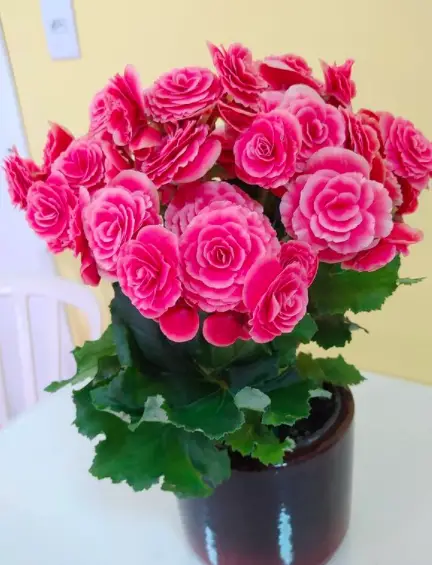All Begonia x tuberhybrida Begonia sutherlandii (tuberous) Begonia rex (rhizomatous) Begonia masoniana (rhizomatous) information included in this article. You can read here more information about Wax begonia, Begonia rex, Begonia grandis, Begonia elatior, and Angel wing begonia.

The begonia family contains more than 900 species and 10,000 hybrids and cultivars. Some are grown mainly for their flowers, others for their leaves, but most of the flowering types also have attractive foliage. Plants range in size from tiny ground creepers to climbers 10ft/3m high. In general, they don’t need much direct sunlight, so most of them make suitable indoor plants.

Begonias bear male and female flowers, sometimes in clusters and sometimes separately. Male flowers last for only a few days but usually compensate for this by being more striking, often having several layers of petals. Female flowers have four petals and are distinguished by a winged or strongly angled seed pod; they also remain on the plant for weeks or even months.

Since the genus is so large and diverse, it is best divided into three groups, distinguished by the root structure. The first group has fibrous-rooted plants, which grow from a tangle of fine roots that will fill a pot quickly. The second contains the rhizomatous begonias, most of which have a thick, fleshy rhizome that crawls over the surface of the potting mix, sending down roots as it goes. The final group contains the tuberous begonias, which are characterized by swollen underground stems, or tubers; they are deciduous and have an annual period of dormancy.

FACT FILE Begonia
ORIGIN Tropical America; Africa; Asia; hybrids.
HEIGHT To 18in/46cm and more.
POTTING MIX Peat-moss-based, or peat-moss- and soil-based in equal parts by volume.
REPOTTING: Fibrous: Move plants into pots one size larger every spring until 6-8-in/15-20-cm pots are reached, then top-dress annually instead. Rhizomatous: Shallow- rooted and best grown in shallow pots. Move into a pot one size larger only when the rhizome has covered much of the surface of the soil. Tuberous: Move semituberous types into pots one size larger each spring.
PROPAGATION: Fibrous: Take 3-4-in/8-10-cm stem cuttings of nonflowering shoots in spring or summer. Rhizomatous and tuberous: By seed, division, leaf, or stem cuttings in spring or summer.
KEEPING PLANTS All begonias suffer in dry air, so increase humidity by standing pots on moist pebbles, particularly if the temperature rises above 65°F/ 18°C.

PLANT CARE Begonia
- Fibrous: Foliage plants require bright light, not the direct sun; flowering plants need up to 4 hours’ direct sunlight.
- Minimum winter temperature of 55°F/13°C; normal room temperature at other times.
- Allow the top lin/2.5cm of the potting mix to dry out between waterings; water less frequently in winter.
- Apply a weak liquid fertilizer every 2 weeks during the period of active growth.
- Rhizomatous and tuberous: Bright, filtered light; plants that lose their top growth do not require light during dormant periods.
- Minimum winter temperature of 55°F/13°C.
- Let the top lin/2.5cm of soil dry out between waterings; do not water dormant plants.
- Apply a high-potash liquid feed every 2 weeks in the period of active growth.

PESTS & DISEASES Care For Begonia
Begonias are affected by root-knot eelworm, tarsonemid mites, weevils, powdery mildew, and botrytis.
Tips And Guides For Begonia
- Begonia ‘Corallina de Lucerna’ (fibrous) is a vigorous plant up to 6ft/1.8m high. The big lance-shaped glossy leaves are spotted with white and deep red below; flowers in large clusters are deep pink to bright red.
- Begonia x tuberhybrida is the most popular tuberous begonia. The 12-in/30-cm-tall fleshy-stemmed plants carry large and showy single, semidouble, and double blooms in a wide range of colors.
- Begonia sutherlandii (tuberous) is 6-8in/ 15-20cm high, with pendulous deep pink stems and red-edged bright green leaves. It bears dainty salmon-pink flowers for 8 months of the year from early spring.
- Begonia rex (rhizomatous) has decorative heart-shaped foliage with zones of silver, pink, purple, cream, and near black on the corrugated leaf surfaces. Many named forms are available.
- Begonia masoniana (rhizomatous), the iron cross begonia, has deeply puckered leaves. They are bright green, with a mahogany-red cross resembling the German iron cross in the center.